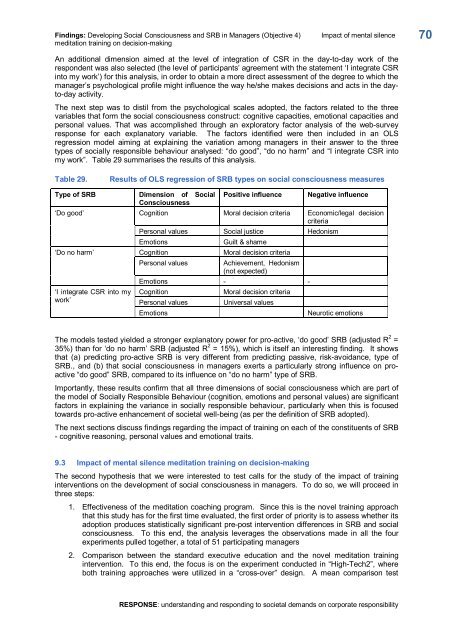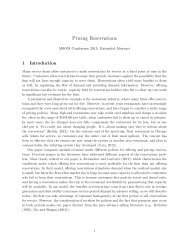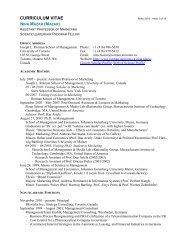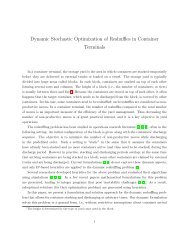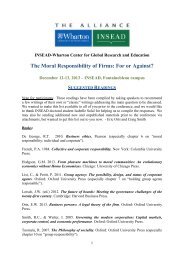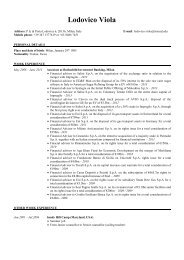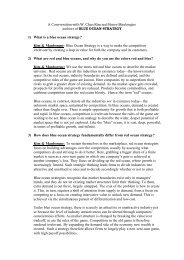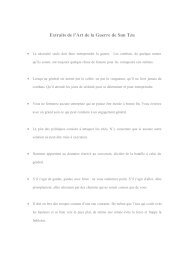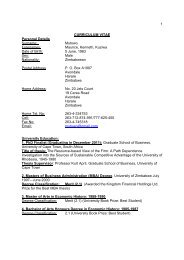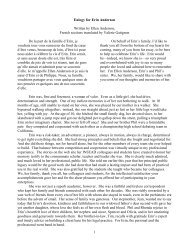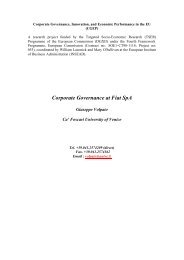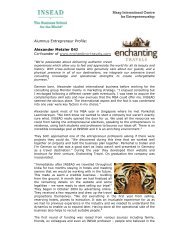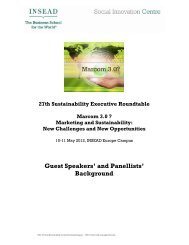RESPONSE - Insead
RESPONSE - Insead
RESPONSE - Insead
Create successful ePaper yourself
Turn your PDF publications into a flip-book with our unique Google optimized e-Paper software.
Findings: Developing Social Consciousness and SRB in Managers (Objective 4) Impact of mental silence<br />
meditation training on decisionmaking<br />
An additional dimension aimed at the level of integration of CSR in the daytoday work of the<br />
respondent was also selected (the level of participants’ agreement with the statement ‘I integrate CSR<br />
into my work’) for this analysis, in order to obtain a more direct assessment of the degree to which the<br />
manager’s psychological profile might influence the way he/she makes decisions and acts in the day<br />
today activity.<br />
The next step was to distil from the psychological scales adopted, the factors related to the three<br />
variables that form the social consciousness construct: cognitive capacities, emotional capacities and<br />
personal values. That was accomplished through an exploratory factor analysis of the websurvey<br />
response for each explanatory variable. The factors identified were then included in an OLS<br />
regression model aiming at explaining the variation among managers in their answer to the three<br />
types of socially responsible behaviour analysed: “do good”, “do no harm” and “I integrate CSR into<br />
my work”. Table 29 summarises the results of this analysis.<br />
Table 29. Results of OLS regression of SRB types on social consciousness measures<br />
Type of SRB Dimension of Social<br />
Consciousness<br />
‘Do good’<br />
‘Do no harm’<br />
‘I integrate CSR into my<br />
work’<br />
Positive influence Negative influence<br />
Cognition Moral decision criteria Economic/legal decision<br />
criteria<br />
Personal values Social justice Hedonism<br />
Emotions Guilt & shame<br />
Cognition Moral decision criteria<br />
Personal values Achievement, Hedonism<br />
(not expected)<br />
Emotions <br />
Cognition Moral decision criteria<br />
Personal values Universal values<br />
Emotions Neurotic emotions<br />
The models tested yielded a stronger explanatory power for proactive, ‘do good’ SRB (adjusted R 2 =<br />
35%) than for ‘do no harm’ SRB (adjusted R 2 = 15%), which is itself an interesting finding. It shows<br />
that (a) predicting proactive SRB is very different from predicting passive, riskavoidance, type of<br />
SRB., and (b) that social consciousness in managers exerts a particularly strong influence on pro<br />
active “do good” SRB, compared to its influence on “do no harm” type of SRB.<br />
Importantly, these results confirm that all three dimensions of social consciousness which are part of<br />
the model of Socially Responsible Behaviour (cognition, emotions and personal values) are significant<br />
factors in explaining the variance in socially responsible behaviour, particularly when this is focused<br />
towards proactive enhancement of societal wellbeing (as per the definition of SRB adopted).<br />
The next sections discuss findings regarding the impact of training on each of the constituents of SRB<br />
cognitive reasoning, personal values and emotional traits.<br />
9.3 Impact of mental silence meditation training on decisionmaking<br />
The second hypothesis that we were interested to test calls for the study of the impact of training<br />
interventions on the development of social consciousness in managers. To do so, we will proceed in<br />
three steps:<br />
1. Effectiveness of the meditation coaching program. Since this is the novel training approach<br />
that this study has for the first time evaluated, the first order of priority is to assess whether its<br />
adoption produces statistically significant prepost intervention differences in SRB and social<br />
consciousness. To this end, the analysis leverages the observations made in all the four<br />
experiments pulled together, a total of 51 participating managers<br />
2. Comparison between the standard executive education and the novel meditation training<br />
intervention. To this end, the focus is on the experiment conducted in “HighTech2”, where<br />
both training approaches were utilized in a “crossover” design. A mean comparison test<br />
<strong>RESPONSE</strong>: understanding and responding to societal demands on corporate responsibility<br />
70


